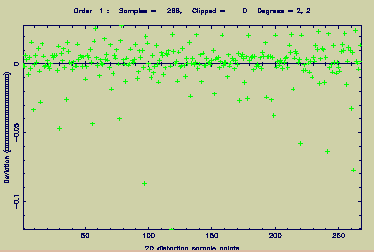13.2 Fit 2D polynomials to the distortion. A typical interactive plot appears below.

13.3 Re-bin the order into a corrected 2-D form.
13.4 Extract from the re-binned form.
This option is used to perform a full 2-D distortion-corrected extraction and is provided for cases where the distortion of the frame is significant.
The option consists of four steps as follows:
13.1 Calculate wavelength scale.
13.2 Fit 2D polynomials to the distortion.
A typical interactive plot appears below.

13.3 Re-bin the order into a corrected 2-D form.
13.4 Extract from the re-binned form.
Distortion correction is done on a per-order basis, each order having it's own distortions mapped independently. The distortion is modelled by using a tie-point data set composed of the positions and wavelength of all identified arc lines in the order.
Thus, a wavelength calibration is a pre-requisite to the distortion corrected extraction operation. A 2-D Chebyshev polynomial is then fitted to the wavelength deviations of each arc line pixel, relative to the wavelength at the trace/arc line intersection. The polynomial is used to generate delta-wavelength values at pairs of (X,Y-offset) coordinates:
delta-wavelength = 2dPoly( X-pixel, Y-offset from trace )
for all X- and all Y-offsets within the dekker.
This map of wavelength delta values is then used to drive a 2-D scrunch of the order into a form where each column (X=nn) corresponds to consistent wavelength increment.
The final step is to extract the data from this re-binned form. The extraction algorithm used is identical to the 1-D case from this point on (See 1-D extraction option for more information).
Martin Clayton